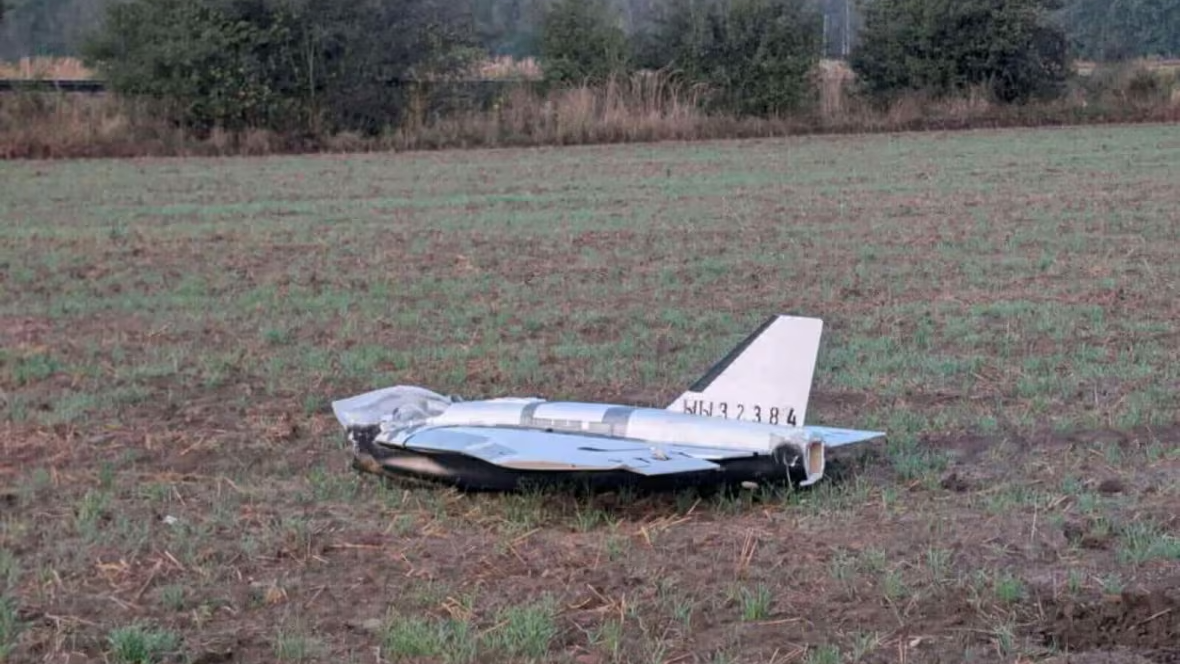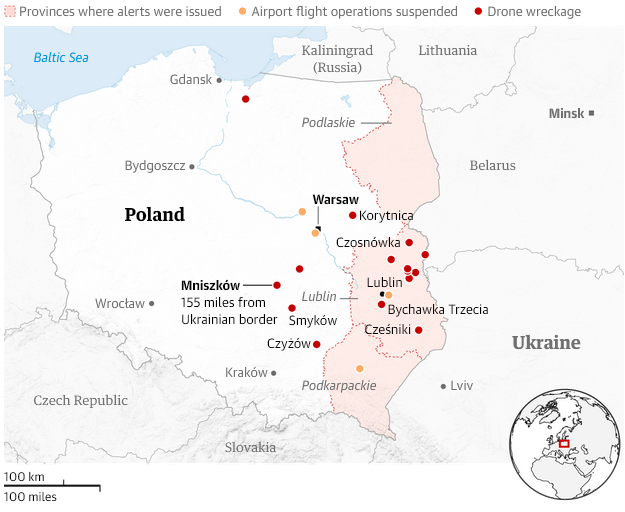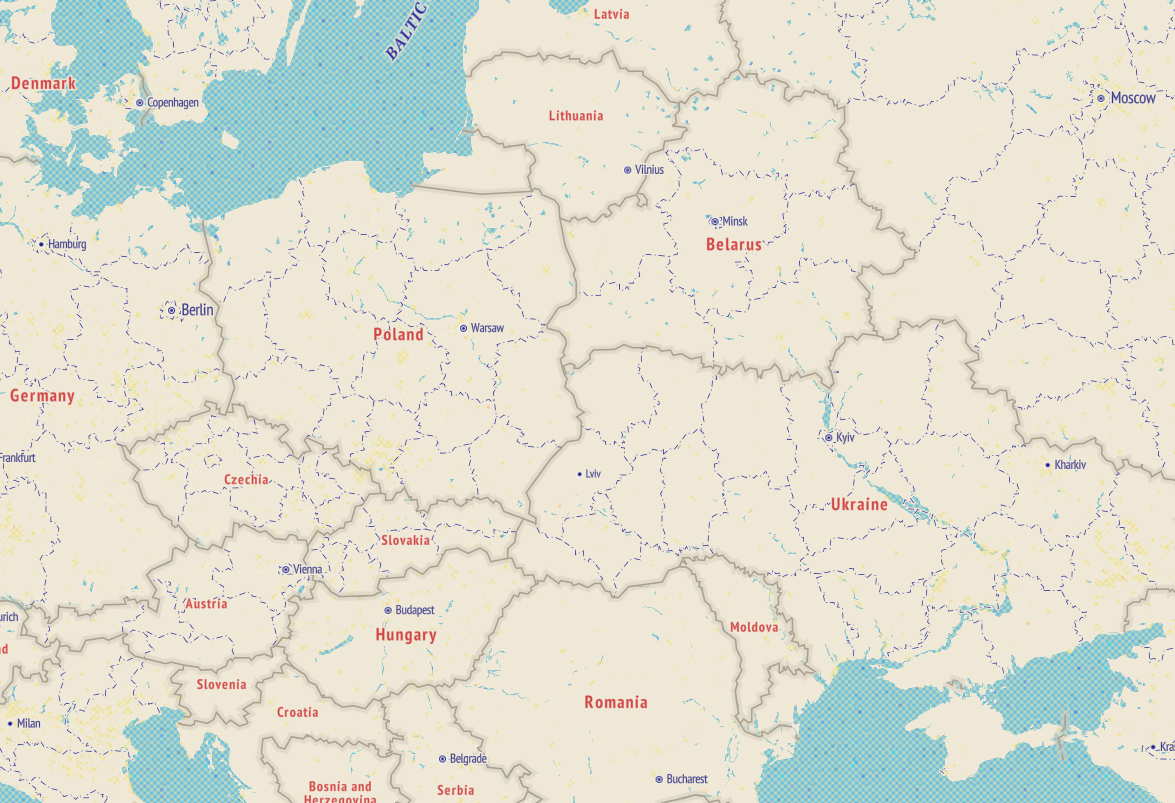NATO Claims It Has Shot Down Russian Drones over Poland
In a very scary escalation, Russian drones seem to have been shot down over Poland. Now NATO is stepping up the rhetoric and gearing up for a possible war with Russia.

Photo of one of the drones in Poland that were reportedly shot down by NATO (Dariusz Stefaniuk/Reuters)
NATO has reportedly scrambled F-35 interceptors from the Netherlands to shoot down Russian drones that had entered Polish airspace. If this reporting is correct, this incident is the first time NATO directly engaged the Russian military since the war in Ukraine began in 2014.
The last comparable confrontation between NATO and Russian forces occured on 10 March 1964, when several Soviet Air Forces MiG-21 fighters shot down a US Air Force RB-66 Destroyer reconnaissance plane near Gardelegen in East Germany. The plane had strayed from the air corridor to West Berlin and the Soviets accused the crew of spying.
cf.: A Brief History of U.S. Navy Cold War Aviation Incidents (Excluding Korea and Vietnam), US Naval History and Heritage Command
The BBC has a report of what happend over Poland this week:
In the early hours of Wednesday, three Russian drones were shot down after crossing into Polish airspace. Other drones crashed to the ground and were later found across eastern Poland. Although Russian drones and missiles have trespassed into some Nato member countries before, this was the most serious incident of its kind since Moscow launched its full-scale invasion of Ukraine in February 2022.
The Kremlin said it had no further comment to make on claims that Russia had deliberately sought to stoke tensions in Poland.
On Thursday, Nato’s top military commander Alexus Grynkewich acknowledged it was not yet known whether the act had been intentional and said even the precise number of drones which had crossed into Polish airspace was still to be determined.
More details in a story from The Guardian:
There had been at least 19 violations of Polish airspace overnight, said Tusk, and some of them had entered Poland from Belarusian territory. Four Polish airports, including the two that serve Warsaw, were closed to traffic during the incursion. The prime minister of the Netherlands, Dick Schoof, said F-35 jets from his country took part in the mission to intercept the drones. At least three drones were shot down.
Russia launches almost nightly attacks on Ukraine using large, kamikaze drones based on an Iranian design and known informally as “Shaheds”. Ukraine’s president, Volodymyr Zelenskyy, said on Wednesday morning that 415 drones and 40 missiles had been used in the overnight attack, most targeting western parts of the country. One person was killed in Zhytomyr region.
Russia’s chargé d’affaires in Poland, Andrei Ordash, called the accusations against Moscow groundless, saying “no evidence has been presented proving these drones are of Russian origin”.
According to Reuters, Belarus (which is allied with Russia, albeit with sometimes strained relations) has claimed it shot down some drones (presumably Russian ones) during the incident:
Belarus said on Wednesday that it had shot down some drones which went astray due to electronic jamming during an exchange of strikes between Russia and Ukraine, and that Minsk had informed Poland and Lithuania of the approach of the drones. The statement by Belarus Chief of the General Staff Major General Pavel Muraveiko did not say whose drones — also known as unmanned aerial vehicles (UAVs) — went astray.
“During the night-time exchange of strikes by UAVs between the Russian Federation and Ukraine, the Air Defence Forces and assets of the Republic of Belarus on duty continuously tracked UAVs that had lost their track as a result of the impact of the parties’ electronic warfare assets,” Muraveiko said in a statement issued in English. “Some of the lost drones were destroyed by our country’s Air Defence Forces over the territory of the republic,” he said.
Muraveiko said Poland and Lithuania were informed of the approach of the drones. “This allowed the Polish side to respond promptly to the actions of the drones by scrambling their forces on duty,” Muraveiko said.
Even with this advance warning, the question of how F-35s from the Netherlands could respond quickly enough to take down drones attacking the east of Poland has been left largely unanswered. I assume the planes were part of a routine patrol and already in Polish airspace or near it. According to reporting by the Frankfurter Allgemeine Zeitung from Germany, some of the drones were tracked by German military personnel operating MIM-104 Patriot SAM batteries in Poland and by an Italian AWACS plane. Several other drones crashed when they ran out of fuel, one in the northernmost part of Poland near Gdańsk on the Baltic.

Crashed drones in red (graphic from The Guardian)
The jamming angle mentioned by the Belarussian officials is interesting because of a story from last week about EU Commission President Ursula von der Leyen’s plane supposedly being diverted due to Russian GPS jamming. Here’s a report from NBC News:
A plane carrying the continent’s top official lost its GPS navigation while midair over the continent’s wary east over the weekend and was forced to land using paper maps. This was the most high-profile case yet, officials and experts said Tuesday, of a Russian strategy that is not only disrupting travel but imperiling lives.
This story later turned out be made up, meaning somebody on the EU side lied about the incident. This was so obvious that anyone with ten hours in Microsoft Flight Simulator could have told you it was bullshit. Or anyone who looked at the public ADS-B data, which showed accurate GPS data throughout the flight.
While many modern planes have GPS systems on board and pilots use them in day-to-day navigation, they are not required to operate the plane in any situation whatsoever and therefore, GPS jamming is at most an inconvenience for pilots.
While GPS systems use satellite transmissions from space, airplane navigation generally uses ground-based radio frequency transmitters. Commercial airliners and military aircraft are also equipped with radar that can be used to navigate. If all else fails, you can also navigate via the compass or with inertial navigation systems, especially under visual flight rules (VFR).
Radio-based navigation systems for aircraft include VOR beacons and ADF systems. For landings, like in the case of von der Leyen’s plane, most airports are equipped with ILS which uses VHF/UHF radio to guide the plane in to land. In some cases, this would theoretically enable the autopilot to get the plane to touchdown on the runway. But that capability only exists at few airports like London Heathrow, Dubai International or Charles de Gaulle in Paris — normally ILS guides the pilot in while they are flying the final approach manually.
These navigation aids are used together with aeronautical charts and airport approach diagrams — this is what some journalists have stupidly called “paper maps” in some of the aforementioned press reports. In reality, these charts are usually digital these days and can be stored in the plane’s cockpit systems or on devices like an iPad.
Unlike planes however, drones often do depend on GPS navigation. Which is why the repeated mentions of jamming is interesting. These drones could have very well been jammed by the Ukrainians, causing them to drift across Belarus and into Poland instead of hitting Ukraine.

The region in question (map from Mapbox)
The rival theory would be that NATO is correct and that the information from Belarus is misdirection. I haven’t seen any footage that would support the Belarussian claim to have shot down drones. In this case, the strategy from the Russian side would have been to test NATO’s reaction and air defence readiness, I guess?
To be honest, with all the information available being from highly propagandised sources, I am not sure who to believe. NATO and the EU are not above making shit up, as seen in the abovementioned von der Leyen story, and seem to be intend on war. And, naturally, I don’t trust the Russian side either. All I know is that this incident seems to be another hefty escalation in the conflict, leading us another step closer to an open war between two nuclear superpowers.
